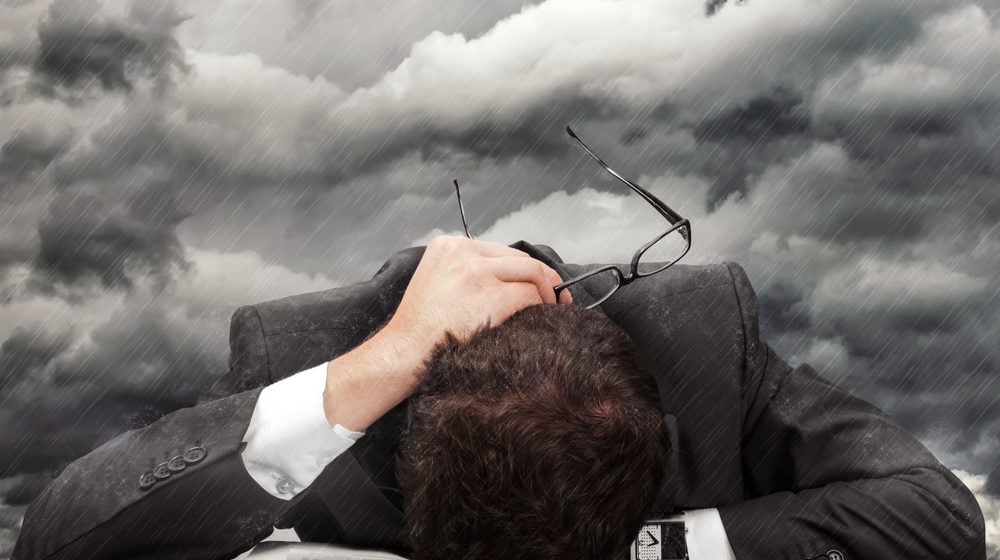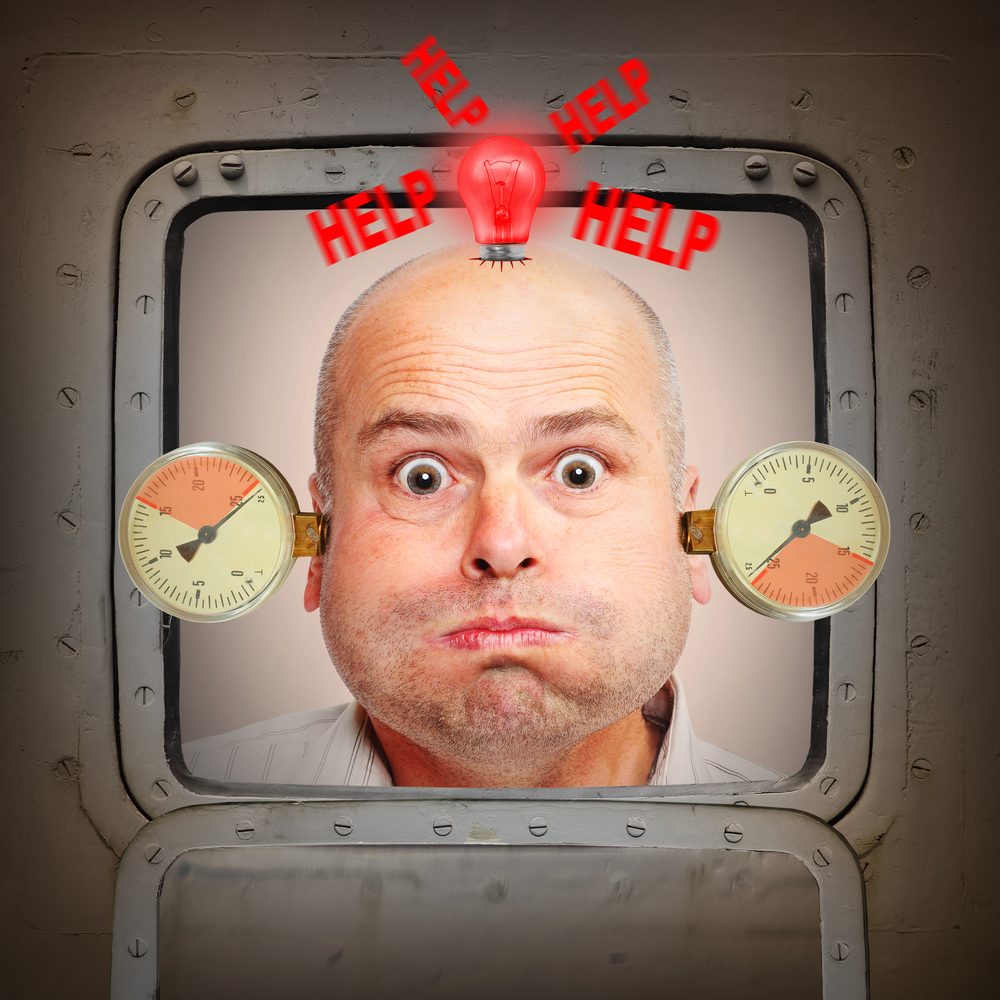
Pressure Produces Headaches
When it rains on your day off or right after you wash your car, that can be a real bummer.
Bad weather can certainly affect your mood, and possibly even cause an emotional outburst.
As it turns out, a rise or fall in barometric pressure can also cause headaches.
Have you ever had a sinus headache?
When your sinuses are not flowing properly pressure builds up.
This intense pressure located in the region of your nose can cause additional pressure behind your forehead and temples.
So when your sinuses are not working properly, you could get a headache.
Sinus pressure is not the only type of pressure which can get your head pounding.
Whether the barometric pressure is rising or falling, and how rapidly it is doing so, has a big effect on your odds of developing a headache.
If you already have a headache, this weather phenomenon can either ease your pains and aches, or make them worse.
The relationship is so common that it has a name.

Man under pressure Headaches
A Barometric Pressure Headaches occurs when the barometer shows a rise in air pressure.
While researchers still do not fully understand how barometric pressure directly affects migraines and other types of headaches, the relationship is too hard to ignore.
Scientists believe dramatic increases in barometric pressure, the amount of pressure the air around you is experiencing, cause similar pressure on your head and your brain.
Others believe this has to do with the accompanying change in oxygen levels that occurs when the barometer rises or falls dramatically.
You have probably noticed you are more at risk of developing a headache when you are flying, hiking or camping, because of the reduced amount of oxygen in the air you breathe.
The same thing happens when the barometer is rising.
The American National Headache Foundation believes that electrical charges in the air, which change dramatically when air pressure is falling or rising rapidly, may have something to do with the fact that more migraines and regular headaches are experienced and reported during dramatic weather events.
The takeaway is this – when barometric pressure rises rapidly, you may get a headache as a result.
However, a quick drop on the barometer may also trigger a headache.
Extreme weather events of any kind could cause a headache to develop, whether it is a serious migraine or just a slight pounding in your temples and forehead.
Headache and migraine triggers: Why weather?
Headache experts are still unraveling the mysteries of migraines and other headaches.
Most believe a combination of factors is involved.
These factors range from genetics to neuron-vascular imbalance in the brain.
However what role could weather play?
One compelling evolutionary theory is that getting a headache is a protective mechanism against adverse environmental stressors.
The theory is that headache pain would cause someone to seek a safer, more hospitable environment.
The fact that changes in weather and extremes in heat and cold cause headache, some experts believe, gives credence to this theory.
These experts also believe that people who get frequent headaches have a greater sensitivity to changes in the environment.
They also have a lower pain threshold. The reason for these things, the experts say, could be that people with migraines have probably inherited this sensitivity.
The same survey also found that two out of three headache sufferers had not discussed environmental triggers with their doctors.
However, nearly half of them had been plagued by headaches for more than 20 years.
What are the symptoms of migraines?
The pain of a migraine can be described as a pounding or throbbing.
The headache often begins as a dull ache and develops into a throbbing pain.
The pain is usually aggravated by physical activity. Migraine pain can be classified as mild, moderate, or severe.
Some other associated symptoms of migraine headaches include:
- Sensitivity to light, noise and odours
- Nausea and vomiting, stomach upset, abdominal pain
- Loss of appetite
- Sensations of being very warm or cold
- Paleness
- Fatigue
- Dizziness
- Blurred vision
Types of migraines
There are several types of migraine headaches, including:
- Migraine with aura: This type is usually preceded by an aura. Most often, an aura is a visual disturbance (outlines of lights or jagged light images).
- Migraine without aura: This type accounts for 80% of migraine headaches. There is no aura before the migraine headache.
- Status migrainosus: This is the term used to describe a long-lasting migraine that does not go away on its own.
How are migraines treated?
People with migraine headaches can manage mild-to-moderate attacks at home with the following strategies:
- Applying a cold compress to the area of pain
- Resting with pillows comfortably supporting the head or neck
- Drinking a moderate amount of caffeine
- Trying certain over-the-counter headache medications
- Resting in a room with little or no sensory stimulation (light, sound, odours)
- Withdrawing from stressful surroundings
- Sleeping
When these efforts do not help, migraine headaches may be eased with prescription medications.
Migraines can be treated in two ways: with abortive therapy or preventive therapy.
The goal of abortive therapy is to prevent a migraine attack or to stop it once it starts.
Some abortive therapies include:
Analgesics like ibuprofen and paracetamol.
Anti-emetic medication may be required.
Triptans (5HT1 agonists) reverse the widening of blood vessels that is believed to cause the headache and include almotriptan, eletriptan, frovatriptan, naratriptan, rizatriptan, sumatriptan and zolmitriptan.
Ergot alkaloids like ergotamine tartrate.
Preventive treatments are considered if migraine headaches occur more than once a week.
These medications are meant to lessen the frequency and severity of the migraine attacks.
Preventive treatment medications include:
- Medications used to treat high blood pressure such as propranolol and verapamil.
- Antidepressants such as amitriptyline.
- Antiseizure medications such as topiramate and gabapentin.
- Some other medications such as methysergide and pizotifen.
Sources:
http://www.relieve-migraine-headache.com/barometric-pressure-headache.html
http://www.webmd.com/migraines-headaches/headache-and-migraine-trigger-weather#1

